31 Perennial Flowers with Pictures and Names
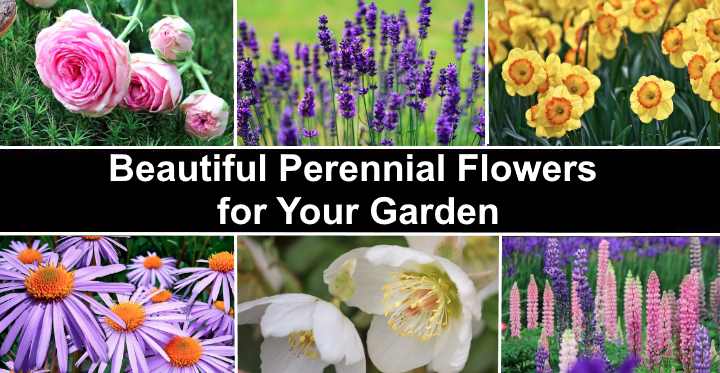
Perennial flowers are ideal for adding color and long-lasting beauty to your garden landscape. Flowering perennial plants return year after year, making them ideal for low-maintenance gardening. The flowers, bulbs, and shrubs transform outdoor spaces into vibrant, colorful front and backyards.
Perennial flowers are popular with gardening enthusiasts. They require little care and produce colorful blooms in spring, summer, or fall. They are also highly adaptable plants that survive in various climates and soil types.
This article provides a comprehensive list of perennial flowers along with pictures and names. Descriptions of each flower’s characteristics and growing requirements will help you choose the best perennials to add to your garden for long-lasting beauty.
What are Perennials?
Perennials are long-living plants that live for more than two years. Unlike annuals, with a life cycle of one season, perennials regrow from their roots year after year. Perennial flowers can be woody shrubs, flowering vines, herbaceous flowers, or spring bulbs. Without much attention, perennials contribute to diverse and vibrant gardens year after year. Examples of perennial flowers include daylilies, coneflowers, lavender, peonies, and many more.
What’s the Difference Between Annuals and Perennials?
Annual flowers grow for one long season, often into the fall, then die with the onset of freezing weather. In contrast, perennials have a longer lifespan, persisting for multiple years. During winter, the above-ground portion of the perennial plant dies back in freezing weather but regrows from the base and rootstock in the following spring to bloom again.
When to Plant Perennials
The best time to plant perennials is in spring or early fall. During these seasons, the soil is workable, and temperatures are moderate. Planting perennials in spring or fall allows them to establish strong root systems before harsh weather arrives. However, specific timing varies by region and plant type.
Why The Perennials in the List Are So Easy to Grow
Perennial flowering shrubs, bulbs, and vines on this list are easy to grow due to their adaptability, resilient nature, and long life cycles. Once established, the perennials require minimal care, as their root systems persist through seasons, reducing the need for replanting. The hardy and undemanding plants help make gardening effortless.
List of Perennial Flowers with Pictures and Names
Let’s look in detail at some of the best carefree perennial flowers that grow effortlessly in your garden landscape.
English Lavender (Lavandula angustifolia)

English lavender is a fragrant purple-flowering perennial prized for its aromatic blooms and silvery foliage. The herbaceous plant has a compact, bushy habit and blooms for several weeks in summer. The purple flowers bloom on upright stems, and the plant’s foliage consists of narrow leaves that turn gray-bronze in winter.
English lavender grows up to 3 ft. (0.9 m) tall and thrives in well-drained soil and full sun. Once established, it flourishes in various soil conditions with almost zero maintenance needs. It’s an ideal choice for low-maintenance gardens.
- USDA Growing Zones: 5 to 9
- Mature Plant Size: 1 to 3 ft. (0.3 – 0.9 m) tall and wide
- Sun exposure: Full sun
- Blooming Season: Throughout summer and sporadically in the fall
Butterfly Bush (Buddleia)
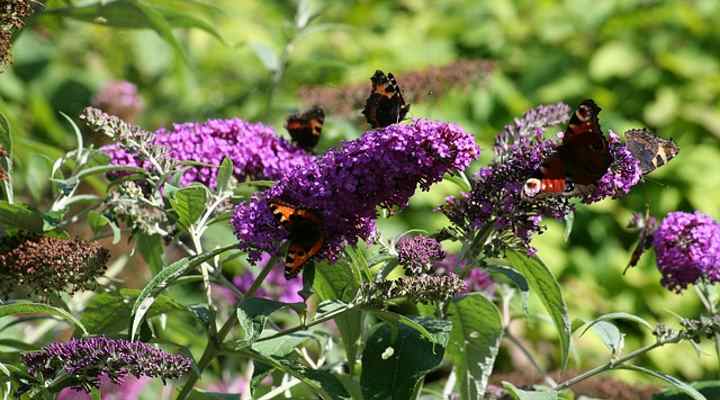
The butterfly bush is an attractive flowering perennial known for its vibrant, nectar-rich blossoms that attract butterflies. The conical flower clusters have a graceful arching form as they bloom continuously from summer to fall. The eye-catching flowers bloom in yellow, pink, white, and purple shades. The intensely fragrant flowers add to its ornamental appeal.
This fast-growing perennial shrub grows up to 12 ft. (3.6 m) tall. The sun-loving “plant and forget” shrub tolerates drought and summer heat. In colder zones, the shrub dies back to the ground in winter before returning in early spring. Butterfly bush is ideal in foundation planting, shrub borders, or butterfly gardens.
- USDA Growing Zones: 5 to 9
- Mature Plant Size: 6 to 12 ft. (1.8 – 3.6 m) tall and wide
- Sun exposure: Full sun
- Blooming Season: Mid to late summer through to the first frost
Tulips

Tulips are bulbous perennials blooming with vibrant, cup-shaped, colorful flowers on erect stems. Planted in the fall, these hardy bulbs burst into bloom each spring, creating a stunning display. The lance-shaped leaves and flowers die after flowers. However, the bulbs persist in the ground, ready to bloom again the following spring.
Tulip flowers are some of the first perennials to bloom in early spring. They come in red, yellow, purple, pink, white, and multi-colored shades. The beautiful spring flowers can be simple, cup-shaped, or showy double blooms with ruffled petals. They grow up to 3 ft. (0.9 m) tall, depending on the variety.
- USDA Growing Zones: 3 to 8
- Mature Plant Size: 0.5 to 3 ft. (0.15 – 0.9 m) tall and 4” (10 cm) wide
- Sun exposure: Full sun
- Blooming Season: Spring, starting from late winter
Daffodils (Narcissus)
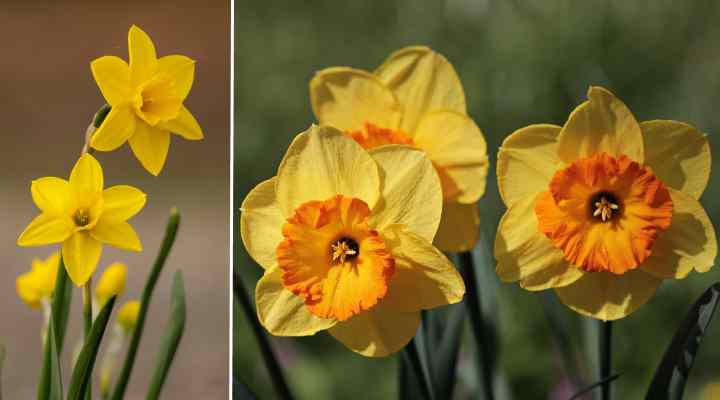
Daffodils are easy-to-plant bulbous perennials with cheerful, trumpet-shaped yellow or white flowers. These hardy plants bloom year after year every spring, creating clumps of attractive foliage and beautiful flowers. The flowers are easily identifiable, with a cup-shaped center surrounded by overlapping petals. They grow up to 2 ft. (0.6 m) tall.
Daffodils require minimal maintenance after planting in the fall. They are hardy perennials that withstand cold temperatures and are deer and rodent-resistant. Daffodils are popular for planting in spring gardens, perennial borders, window boxes, and naturalized areas.
- USDA Growing Zones: 3 to 9
- Mature Plant Size: 0.5 to 2 ft. (0.15 – 0.6 cm) tall
- Sun exposure: Full sun to partial shade
- Blooming Season: Spring
Lupine (Lupinus)

Lupine is a stunning flowering perennial known for its vibrant, spiky flower clusters. The conical clusters of pea-like flowers bloom in late spring and summer in yellow, pink, purple, blue, and white shades. The tall flower spikes rise above the plant’s palmate leaves, creating a dramatic floral display in the garden.
Lupines are a favorite among pollinators, attracting bees, butterflies, and hummingbirds. Not growing taller than 4 ft. (1.2 m) tall, the no-fuss beauties grow vigorously in full sun. Lupines are a great addition to cottage gardens, wildflower gardens, or naturalized areas.
- USDA Growing Zones: 3 to 10
- Mature Plant Size: 1 to 4 ft. (1.2 m) tall and up to 2 ft. (0.6 m) wide
- Sun exposure: Full sun to partial shade
- Blooming Season: Late spring to early summer
Christmas Rose (Helleborus niger)

Christmas rose is a beautiful flowering evergreen perennial with large white, bowl-shaped flowers. Blooming in winter or early spring, the white flowers look stunning with their crowns of vibrant yellow stamens. Additionally, the plant has deeply lobed, palmate leaves that retain their dark green color throughout the year.
Despite its name, Christmas rose is not a member of the rose (Rosa) family. It thrives in partial shade and moist, well-drained soil. Not growing more than one foot (30 cm) tall, the white-flowering perennial is a nice addition to shady borders, underplanting shrubs and trees, or growing in planters in a container garden.
- USDA Growing Zones: 3 to 8
- Mature Plant Size: 1 ft. (0.3 m) tall and up to 2 ft. (0.6 m) wide
- Sun exposure: Partial shade to full shade
- Blooming Season: Late winter to early spring
Shasta Daisy (Leucanthemum x superbum)
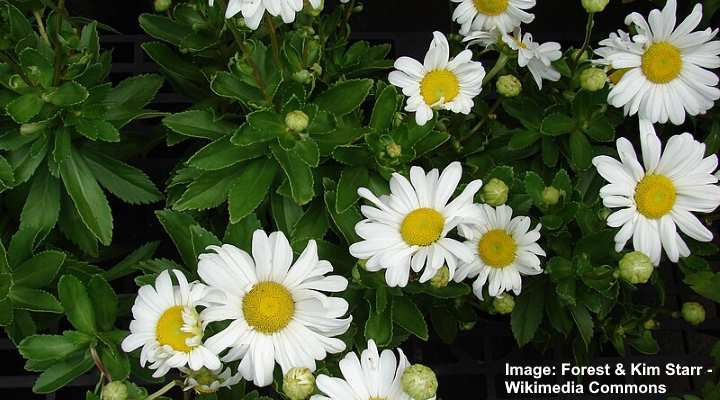
Shasta daisy is a popular flowering herbaceous perennial with large, snow-white flowers. The daisy-like ray flowers have narrow white petals surrounding a yellow center. Its leaves are dark green, lanceolate, with coarsely toothed edges. The daisy-like flowers bloom in abundance on sturdy stems throughout summer.
Shasta daisies are easy to grow and a favorite choice for beginner gardeners. Growing up to 4 ft. (1.2 m) tall, the fragrant white flowers are a great addition to borders, perennial beds, cutting gardens, and containers. They are deer and rabbit-resistant, and the bright white and yellow flowers attract butterflies and bees, boosting your garden’s biodiversity.
- USDA Growing Zones: 4 to 9
- Mature Plant Size: 2 to 4 ft. (0.6 – 1.2 m) tall and 1 to 3 ft. (0.3 – 0.9 m) wide
- Sun exposure: Full sun to partial shade
- Blooming Season: Late spring to early fall
Scarlet Sage (Salvia coccinea)
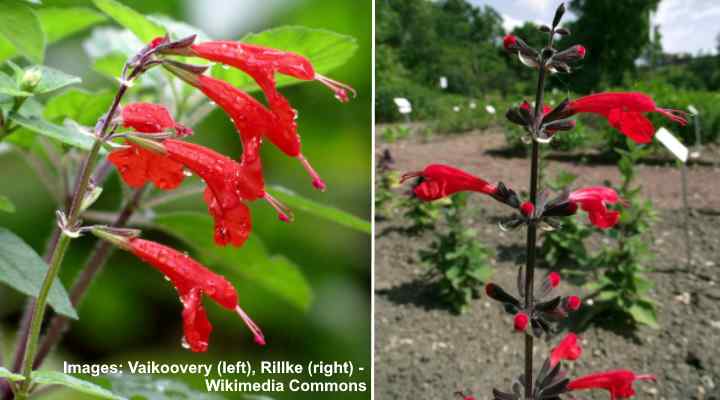
Scarlet sage is a vibrant red-flowering perennial you can plant and forget about. The attractive herbaceous plant has spikes of two-lipped red tubular flowers. These contrast nicely with the plant’s bushy foliage of dark green, heart-shaped leaves. Blooming from early summer, the striking flowers persist for several weeks.
Scarlet sage grows up to 2 ft. (0.6 m) tall and thrives in full sun to partial shade. The hardy, undemanding perennial tolerates heat, humidity, and drought. Its attractive tubular flowers attract bees, butterflies, and hummingbirds. Scarlet sage is ideal for borders, containers, or mass plantings in warm climates.
- USDA Growing Zones: 8 to 10
- Mature Plant Size: 1 to 2 ft. (0.3 – 0.6 m) tall and wide
- Sun exposure: Full sun to partial shade
- Blooming Season: Spring to fall, with peak bloom in summer
Black-Eyed Susan (Rudbeckia hirta)
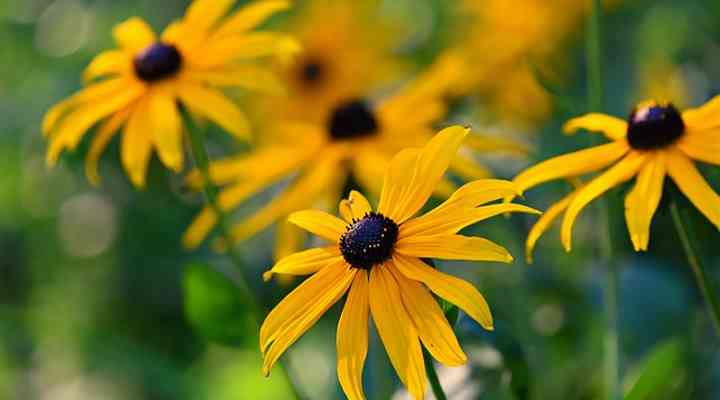
Black-eyed Susan is a popular short-lived tall perennial with bright yellow ray flowers and dark brown, cone-shaped centers. The daisy-like flowers bloom profusely throughout summer and fall, brightening perennial borders, cottage gardens, and mixed beds. Once established, the tall flowers don’t take any work and are low-maintenance plants.
Black-eyed Susan has a clumping habit and grows up to 3 ft. (0.9 m) tall. It’s easy to grow and tolerates a range of conditions, including drought, heat, and humidity. You can easily plant this yellow-flowering plant in wildlife gardens as it attracts pollinators but is deer-resistant.
- USDA Growing Zones: 3 to 9
- Mature Plant Size: 2 to 3 ft. (0.6 – 0.9 m) tall and 1 to 2 ft. (0.3 – 0.6 m) wide
- Sun exposure: Full sun
- Blooming Season: Early summer through fall
Yarrow (Achillea millefolium)
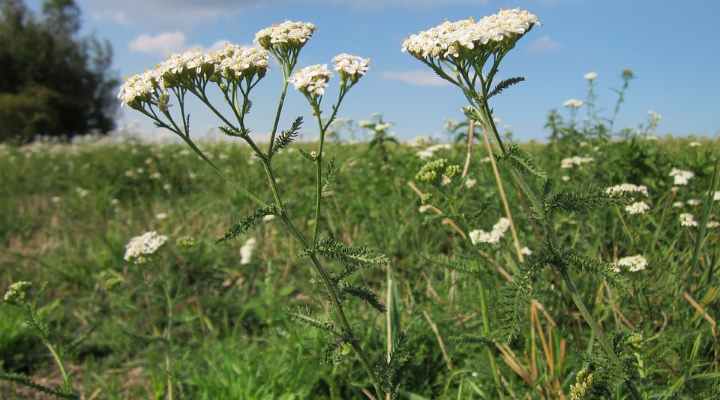
Yarrow is a versatile wildflower perennial known for its feathery foliage and clusters of tiny, flat-topped flowers. The showy flowers bloom throughout summer in white, yellow, pink, and red shades. Its feathery foliage is aromatic and, together with the colorful flowers, looks attractive in garden landscapes. Yarrow is hardy and easy to grow in most soil types.
Yarrow grows up to 3 ft. (0.9 m) tall and is ideal for landscaping hassle-free gardens. Its clumping nature and tolerance to salt spray make yarrow a good choice for coastal gardens. Other landscaping uses include ground cover, mixed borders, and cut flower gardens.
This popular flowering perennial attracts butterflies without enticing deer or rabbits to your wildlife garden.
- USDA Growing Zones: 3 to 9
- Mature Plant Size: 2 to 3 ft. (0.6 – 0.9 m) tall and 1 to 2 ft. (0.3 – 0.6 m) wide
- Sun exposure: Full sun to partial shade
- Blooming Season: Late spring to early fall
Coneflower (Echinacea)

Coneflower is an eye-catching flowering perennial with daisy-like flowers and drooping petals. The large, brown, cone-shaped centers are surrounded by colorful purple, pink, white, and yellow petals. This trouble-free flowering plant almost thrives on neglect, making it a striking addition to no-fuss gardens. Coneflowers grow up to 4 ft. (1.2 m) tall.
Coneflowers are herbaceous perennials that enjoy a long-blooming season from late spring until the first frost. Sun-loving coneflowers can grow in tough conditions and are ideal for beds and borders, cottage gardens, and naturalized areas. The nectar-rich flowers attract pollinators, and birds love the seeds in the fall.
- USDA Growing Zones: 3 to 9
- Mature Plant Size: 2 to 4 ft. (0.6 – 1.2 m) tall and up to 3 ft. (0.9 m) wide
- Sun exposure: Full sun
- Blooming Season: Late spring until early winter
Mexican Marigolds (Tagetes lucida)

Some varieties of marigolds are flowering perennials with fragrant, bright golden flowers and aromatic leaves. As some of the easiest plants to grow, marigolds fill summer gardens with bright, cheerful, daisy-like blooms. Mexican marigolds are typically low-growing plants, ideal for yellow-flowering ground cover, containers, or planting along pathways.
Mexican marigolds grow up to 3 ft. (0.9 m). The four or five-petalled yellow flowers perform best in full sun and soil with good drainage. Due to their intolerance to freezing conditions, marigolds grow as annuals in colder climates. They can tolerate heat and drought, making them a great choice for hot summer climates.
- USDA Growing Zones: 8 to 11
- Mature Plant Size: 0.5 to 3 ft. (0.15 to 0.9 m) tall and 1.5 ft. (0.45 m) wide
- Sun exposure: Full sun, at least six hours of sunlight daily
- Blooming Season: Early summer to late fall
Butterfly Weed (Asclepias tuberosa)

Butterfly weed is a vibrant flowering, zero-maintenance perennial with clusters of bright orange flowers. Blooming continuously throughout summer, the native orange-flowering plant has colorful umbels 5” (13 cm) across. Also, it has stiff, lanceolate leaves and attractive seed pods in the fall. As a member of milkweed plants, this perennial is a valuable food source for monarch butterflies.
Butterfly weed is a hardy plant that can tolerate various soil conditions. Not growing taller than 2 ft. (0.6 m), its colorful flower clusters brighten beds and borders and look attractive growing along a foundation line. An advantage of butterfly weed is that it doesn’t have the milky sap common with other milkweed plants.
- USDA Growing Zones: 3 to 9
- Mature Plant Size: 1 to 2 ft. (0.3 – 0.6 m) tall and wide
- Sun exposure: Full sun
- Blooming Season: Early summer to early fall
Balloon Flower (Platycodon grandifloras)

Balloon flower is a charming perennial with flared, bell-shaped purple-blue flowers and a compact habit. The beautiful five-petalled flowers have a star shape and grow in small clusters. Its foliage is lanceolate leaves that are bluish-green. The long-blooming perennial looks attractive in no-fuss landscapes thanks to its ornamental features.
Balloon flower is an effortless bloomer that grows up to 3 ft. (0.9 m). It thrives in full sun or partial shade and tolerates light, fertile, moist soils. Uses in the landscape for balloon flowers include adding a pop of color to borders, rock gardens, or container planting.
- USDA Growing Zones: 3 to 8
- Mature Plant Size: 1 to 3 ft. (0.3 – 0.9 m) tall and 2 ft. (0.6 m) wide
- Sun exposure: Full sun to partial shade
- Blooming Season: Summer to early fall
Canterbury Bells (Campanula spp.)
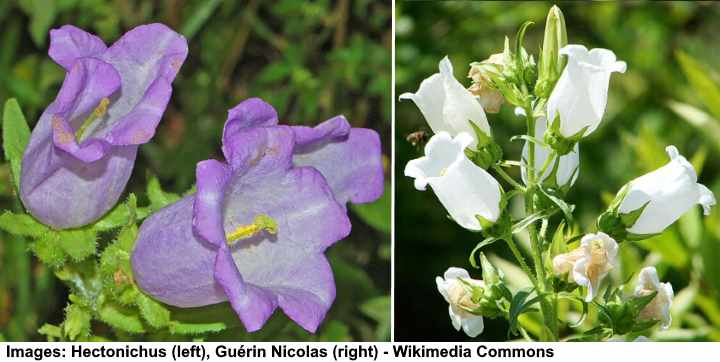
Canterbury bells are charming floriferous perennials with masses of showy bell-shaped flowers. The delicate, papery flowers bloom in dense clusters in late spring and throughout summer. The pink, purple, yellow, or white flowers highlight the lance-shaped dark green leaves. Canterbury bells grow up to 3 feet (0.9 m) tall.
Canterbury bells are hardy, fuss-free perennials with a bushy, upright habit. They thrive in full sun to partial shade and are adaptable to various soil conditions. Landscaping uses for Canterbury bells include underplanting shrubs, borders, or perennial beds. They are versatile flowers that create a stunning visual impact in containers on patios and deck areas.
- USDA Growing Zones: 3 to 9
- Mature Plant Size: 1 to 3 ft. (0.3 to 0.9 m) tall and 2 ft. (0.6 m) wide
- Sun exposure: Full sun to partial shade
- Blooming Season: Late spring until the end of summer
Gayfeather (Liatris spicata)
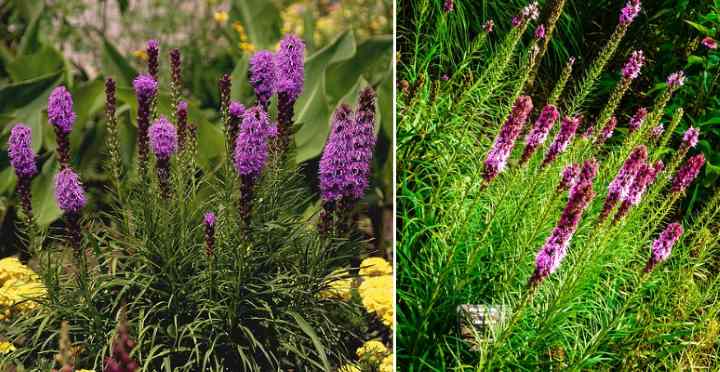
Gayfeather is a stunning tall flowering plant that adds vertical interest to sunny gardens. The tall perennial has slender, leafy spikes topped with upright flower clusters resembling blazing stars. The stalks are covered in narrow, grass-like leaves that stay green throughout summer before turning bronze in the fall. It’s an easy-care, easy-to-grow perennial flower.
Gayfeather grows up to 4 ft. (1.2 m) tall and thrives in well-drained, moderately fertile soil and full sun. It also tolerates a range of harsh growing conditions, including drought, heat, dry soils, and cold. These features make it a great, easy-going perennial for minimal-care landscapes.
- USDA Growing Zones: 3 to 9
- Mature Plant Size: 2 to 4 ft. (0.6 – 1.2 m) tall and 2 ft. (0.6 m) wide
- Sun exposure: Full sun
- Blooming Season: Mid-summer and throughout fall
Catmint (Nepeta racemosa)
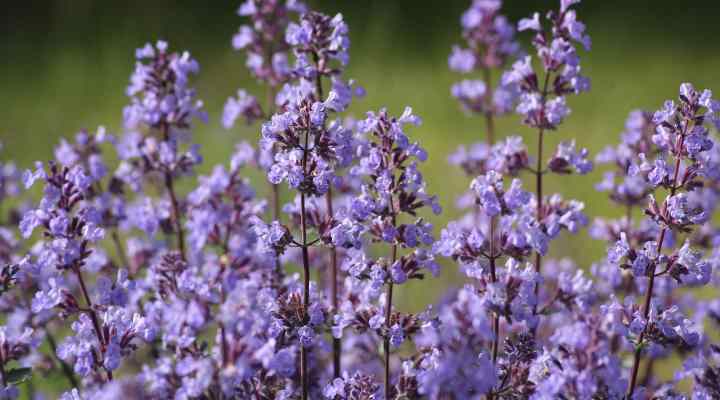
Catmint is a delightful purple-flowering perennial with aromatic foliage and blue, purple, or white flowering spikes. The herbaceous plant has an upright, clumping nature with gray-green foliage and flowers that bloom in late spring and early summer. As its name suggests, the serrated gray-green leaves emit a minty scent when crushed.
Catmint grows in most soil types with no maintenance. Not growing taller than 2 ft. (0.6 m), its ornamental foliage works as ground cover, perennial borders, edging, and rock gardens. It’s also good for growing in containers beside a front entranceway.
- USDA Growing Zones: 4 to 8
- Mature Plant Size: 1 to 2 ft. (0.3 – 0.6 m) tall and wide
- Sun exposure: Full sun to partial shade
- Blooming Season: Late spring through fall
Chinese Astilbe (Astilbe chinensis)
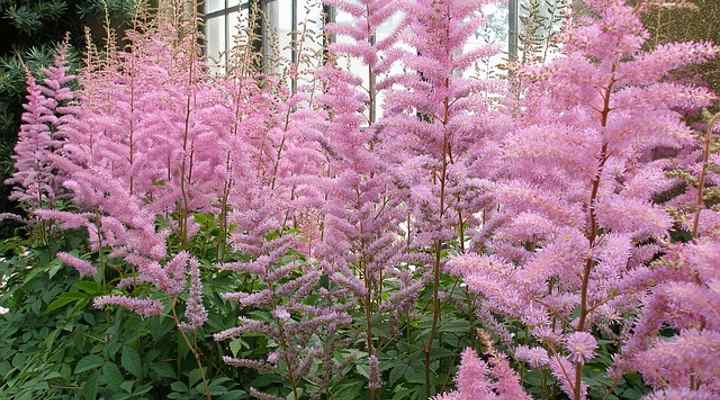
Chinese astilbe produces stunning clusters of fragrant flowers every summer. The flowering perennial is known for its feathery, fern-like foliage, showy plumes of small flowers, and long blooming season. This trouble-free, shade-tolerant perennial grows up to 2 ft. (0.6 m) tall in the shade or dappled sunlight.
Chinese astilbe produces spectacular floral displays in perennial borders, along pathways, or in foundation planting. Also, its low-growing habit makes it a good choice for ground cover in full shade. This low-maintenance plant is deer-resistant and attracts butterflies and bees.
- USDA Growing Zones: 4 to 9
- Mature Plant Size: 1 to 2 ft. (0.3 – 0.6 m) tall and wide
- Sun exposure: Partial shade to full shade
- Blooming Season: Throughout summer
Garden Mums (Chrysanthemum x morifolium)

Garden mums are popular perennial flowers that add a burst of color to gardens and landscapes in the fall. The bushy plants produce vibrant flowers in orange, lavender, yellow, orange, red, pink, and white shades. The showy perennial flowers can be single, double, or star-shaped, contrasting with the dark green, deeply lobed leaves.
Mums are easy to grow and require minimal maintenance in the ground, pots, hanging baskets, or containers. Ideal for full sun or partial shade planting, the perennials grow well as bedding plants that return annually. Also, mums support biodiversity, attracting pollinators like bees and butterflies.
- USDA Growing Zones: 5 to 9
- Mature Plant Size: 1 to 3 ft. (0.3 – 0.9 m) tall and wide
- Sun exposure: Full sun to partial shade
- Blooming Season: Fall, typically from late summer to frost
Bugleweed (Ajuga reptans)

Bugleweed is a low-growing perennial ground cover valued for its attractive foliage and spikes of vibrant purple flowers. The plant forms a dense mat of dark green or purple leaves, forming a rosette pattern. Whorls of small purple, pink, or blue-violet flowers on spikes emerge from the rosettes in mid to late spring.
Bugleweed is a low-maintenance, hardy plant that thrives in various soil conditions. It is also popular for attracting pollinators, such as bees and butterflies. Bugleweed is an ideal landscaping solution for soil erosion, suppressing weeds, and shade planting in perennial borders.
- USDA Growing Zones: 3 to 10
- Mature Plant Size: 4” to 8” (10 to 20 cm) tall
- Sun exposure: Full sun, partial shade, or heavy shade
- Blooming Season: Spring
Creeping Phlox (Phlox stolonifera)
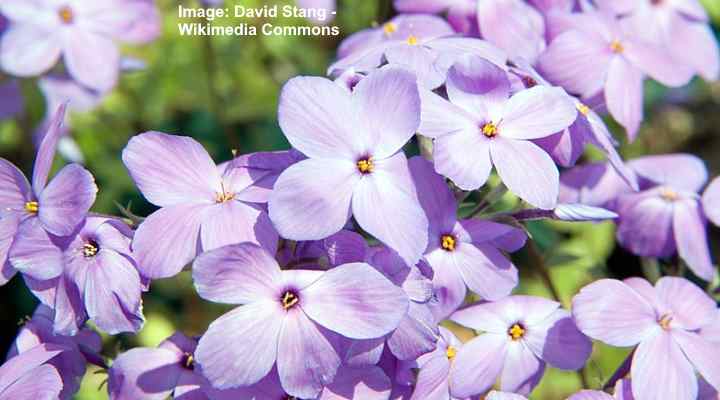
Creeping phlox is a mat-forming perennial ground cover for planting in the sun or shade. The low-growing plant has foliage consisting of oval green leaves contrasting with fragrant, five-petalled purple-violet or lavender-blue flowers. Blooming in mid to late summer, creeping phlox is ideal for underplanting shrubs, ground cover, or adding color to border fronts.
- USDA Growing Zones: 4 to 8
- Mature Plant Size: 3” to 8” (7.5 – 20 cm) tall and up to 24” (60 cm) wide
- Sun exposure: Full sun, partial shade, or deep shade
- Blooming Season: Mid to late summer
Threadleaf Coreopsis (Coreopsis verticillata)

Threadleaf coreopsis is a stunning yellow-flowering perennial with thread-like foliage and bright yellow flowers creating colorful mounds. The daisy-like yellow flowers bloom in clusters during summer and fall. Not growing taller than 2 ft. (0.6 m), the perennial is suitable for planting in sunny parts of your front or backyard.
Also called tickseed, this carefree, self-spreading perennial grows without much care. It adds a splash of sunshine to landscapes. It is useful as an accent plant in mass plantings or for brightening sunny beds and borders. Its attractive, long-lived flowers attract bees and butterflies, but deer ignore them.
- USDA Growing Zones: 3 to 9
- Mature Plant Size: 1 to 2 ft. (0.3 – 0.6 m) tall and wide
- Sun exposure: Full sun, dappled sunlight, or partial shade
- Blooming Season: Early summer to late fall
Perennial Sunflowers (Helianthus spp.)
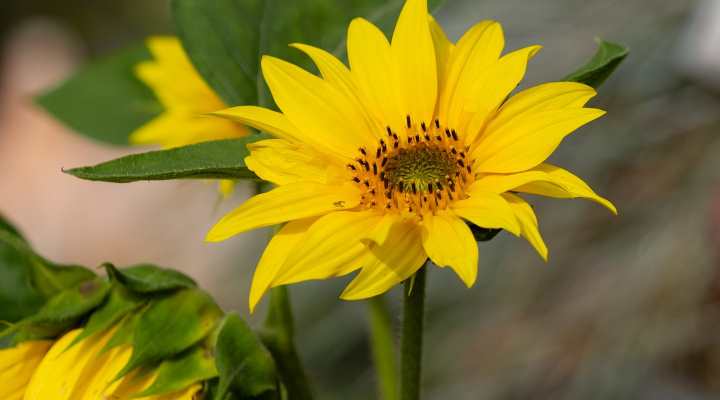
Western Sunflower (Helianthus occidentalis)
Several varieties of sunflowers are flowering perennials with large, vibrant yellow daisy-like flowers. Perennial sunflowers grow from tubers, producing new stems, foliage, and flowers year after year. As with most sunflower plants, perennial varieties have pointed yellow petals in a ray shape around a central disk.
Varieties of perennial flowering sunflowers include the following:
- Western Sunflower (Helianthus occidentalis): A clumping yellow-flowering plant that grows up to 4 ft. (1.2 m) tall.
- Giant Sunflower (Helianthus giganteus): This tall perennial has yellow flowers resembling annual sunflowers. It grows up to 10 ft. (3 m) tall.
- Showy Sunflower (Helianthus x laetiflorus): This cheerful, long-blooming sunflower has bright yellow petals and a crown of stamens in the center. It grows 7 ft. (2.1 m) tall.
- Maximilian Sunflower (Helianthus maximiliani): Also called prairie sunflowers, the flowers have pale yellow petals and a greenish central disk. They grow 3 to 10 ft. (0.9 – 3 m).
Information about growing perennial sunflowers:
- USDA Growing Zones: 4 to 9
- Mature Plant Size: Up to 10 ft. (3 m) tall, depending on the variety
- Sun exposure: Full sun
- Blooming Season: Summer to early fall
Passion Flower (Passiflora)

Passion flower is a stunning perennial vine with exotic and intricate flowers in purple, red, and white shades. The unique flowers have a complex structure—a central disk surrounded by colorful, fringed petals. The flowers come in various colors, including purple, blue, pink, and white. The large flowers, with their wiry stamens, can grow 4” (10 cm) across.
Passionflower vines can grow up to 30 ft. (9 m) tall. In growing Zone 6 and above, the subtropical vines are exotic landscaping options for growing on trellises, fences, or pergolas. The vining perennials thrive in loose, gravelly, or sandy soil that drains well. The attractive flowers attract abundant butterflies in the summer.
- USDA Growing Zones: 6 to 11, depending on the variety
- Mature Plant Size: 10 to 30 ft. (3 – 9 m) tall
- Sun exposure: Full sun to partial shade
- Blooming Season: Summer to fall
Bleeding Heart (Dicentra spectabilis)
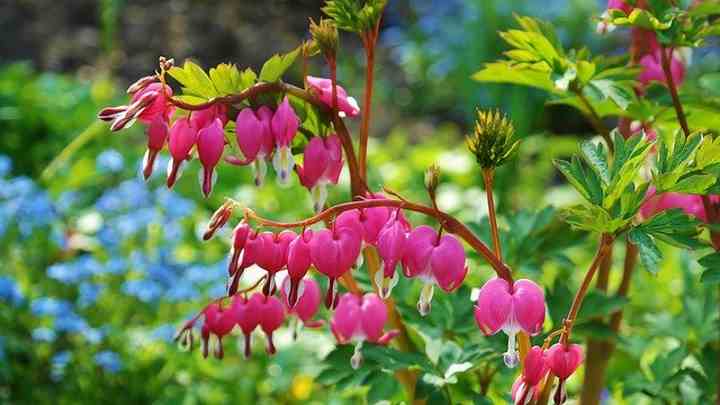
Bleeding heart is one of the most attractive perennial flowers due to its unique reddish, heart-shaped flowers. The eye-catching magenta-red flowers with white protruding petals dangle delicately from arching stems. The graceful stems have fern-like foliage, adding to the plant’s ornamental appeal. The unusual flowers bloom for six weeks in late spring.
Bleeding heart flowers thrive in partial shade, where the perennial grows up to 3 ft. (0.9 m) tall. The plant performs best in moist, well-drained soils, adding color and texture to shaded borders and woodland gardens. This stunning low-maintenance plant adds a touch of romance and beauty to garden landscapes.
- USDA Growing Zones: 3 to 9
- Mature Plant Size: 2 to 3 ft. (0.6 – 0.9 m) tall and wide
- Sun exposure: Partial shade to full shade
- Blooming Season: Late spring to early summer
Bearded Iris (Iris germanica)
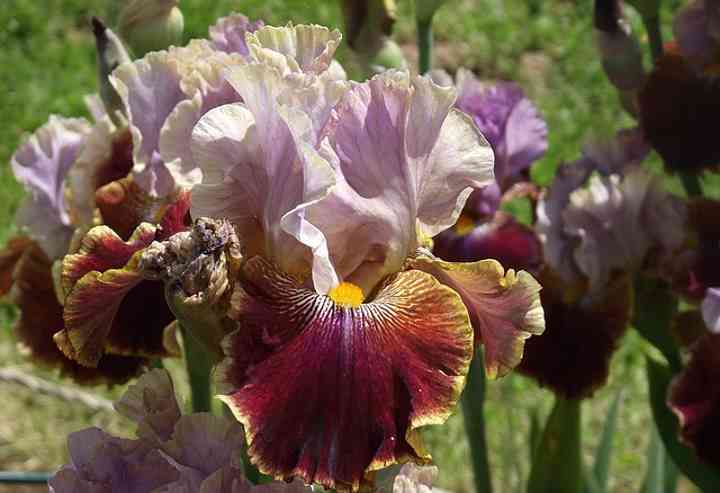
Bearded iris is among the most popular flowering perennials due to its showy blooms and sword-shaped leaves. Iris flowers have ruffled petals—3 upright petals and 3 dropping petals, creating unique multi-colored blooms. The distinctive feature of bearded irises is the fuzzy “beard” that runs along the middle of each flower’s lower petal.
These easy-care perennials grow up to 4 ft. (1.2 m) tall and prefer well-drained soil and full sun. They are carefree and drought-tolerant once established. Over time, the sword-shaped leaves form large clumps, and the flowers come back year after year.
- USDA Growing Zones: 3 to 10
- Mature Plant Size: 1 to 4 ft. (0.3 – 1.2 m) tall and 2 ft. (0.6 m) wide
- Sun exposure: Full sun
- Blooming Season: Late spring and throughout summer
Blanket Flower (Gaillardia grandiflora)
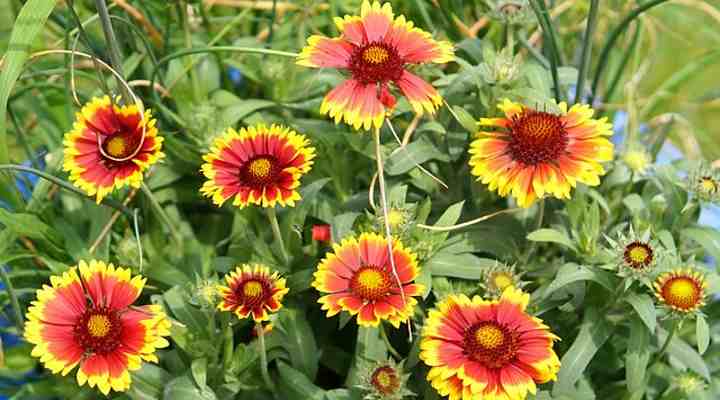
Blanket flower is a vibrant yellow, red or orange-flowering perennial boasting masses of multi-colored daisy-like flowers. The ray flowers have red petals with pointed yellow tips growing on wiry stems. As the name suggests, they bloom for a long time—from late spring to fall—creating a blanket of color in landscapes.
These hassle-free perennials, with their enduring blooms, grow freely in gardens. Not growing taller than 2 ft. (0.6 m), the drought-tolerant flowers are ideal for hot, dry conditions and xeriscaping in low-water gardens. Blanket flowers are short-lived perennials in warm, coastal regions.
In cooler climates, blanket flowers grow as colorful annuals and require planting every year to enjoy their red, orange, and yellow blooms.
- USDA Growing Zones: 2 to 11
- Mature Plant Size: 1 to 2 ft. (0.3 – 0.6 m) tall and wide
- Sun exposure: Full sun
- Blooming Season: Late spring to early fall
Primrose (Primula vulgaris)

Primrose is a charming semi-evergreen perennial with cup-shaped pale yellow flowers. The heavily scented flowers have creamy-yellow petals with a yellow center. The bright flowers bloom in late winter or early spring, contrasting with the toothed, oval, bright green leaves. This easy-grow ground-hugging plant is one of the first perennials to bloom in spring.
Primrose plants have a compact, clump-forming habit and grow less than a foot (0.3 m) tall. The pale yellow flowers add a pop of color to beds and borders, rock gardens, and naturalized areas. Primroses are also suitable for container gardening to brighten shaded patios, deck areas, and balconies.
- USDA Growing Zones: 4 to 8
- Mature Plant Size: 4” to 6” (10 – 15 cm) tall and up to 9” (23 cm) wide
- Sun exposure: Partial shade to full shade
- Blooming Season: Late winter and early spring
Goldenrod (Solidago)

Goldenrod is a vibrant perennial plant known for its stunning cylindrical clusters of yellow flowers. Blooming in summer and fall, the golden yellow flowers create arcing plumes on woody stems. The clusters of small, daisy-like flowers attract bees, butterflies, and other pollinators. Goldenrod perennials grow up to 5 ft. (1.5 m) tall.
Goldenrod yellow flowers are ideal for brightening partially shaded perennial borders, native plant gardens, and naturalized areas. The late-blooming season makes goldenrod flowers ideal as a nectar source for bees in the fall.
It’s good to note that goldenrod is not associated with causing allergies. Air-borne allergens are usually from ragwort, which blooms at the same time.
- USDA Growing Zones: 3 to 9
- Mature Plant Size: 1 to 5 ft. (0.3 – 1.5 m) tall and 1 to 3 ft. (0.3 – 0.9 m) wide
- Sun exposure: Full sun to partial shade
- Blooming Season: Mid-summer to early fall
Roses (Rosa)

Roses are woody flowering perennials known for their romantic flowers, beauty, and fragrance. Typical rose flowers are cup-shaped with ruffled double petals, creating a dense flower head. Roses bloom for a long time, from late spring through fall, in a range of colors, including pink, red, yellow, peach, apricot, and white.
Roses thrive in full sun and well-drained soil. They are relatively high-maintenance perennials because they require regular fertilization and optimal conditions to bloom profusely. However, several rose varieties are low-maintenance woody perennials. These include the following varieties:
- Knockout Roses: Shrub roses with single to semi-double blooms. The woody perennials grow up to 4 ft. (1.2 m) tall and bloom for a long time in drought-prone landscapes.
- Double Knockout Roses: Bushy, deciduous shrub roses with showy double blooms that continue to blossom in hot summers.
- Oso Easy Roses: Low-growing roses with vibrant double blossoms that perform well as flowering ground cover in full sun. They grow 2 to 3 ft. (0.6 – 0.9 m) tall and wide.
- Graham Thomas Roses: This variety of English roses are the most popular rose perennials with incredibly scented, vibrant flowers. The bushy roses grow 5 to 10 ft. (1.5 – 3 m) tall.
Additionally, climbing roses are ideal long-blooming perennials for covering a trellis, pergola, or walls. Compact shrub roses are perfect for borders and foundation planting.
- USDA Growing Zones: 5 to 10, depending on the variety
- Mature Plant Size: 3 to 6 ft. (0.9 – 1.8 m) tall and wide
- Sun exposure: Full sun
- Blooming Season: Late spring to fall
Aster (Aster)
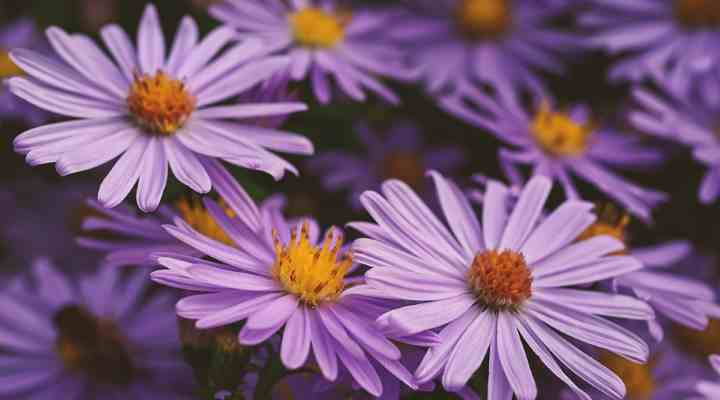
Asters are perennial flowers that bloom all summer and include different types to brighten your garden. The most common aster flower color is purple or lilac. However, many beautiful asters come in shades of pink, white, red, and blue.
Asters are some of the best long blooming perennials to add a splash of color to summer gardens. Aster plants are perfect for growing in borders, mixed flower beds, and anywhere in a garden landscape where you need colorful summer flowers. The beauty of asters is that they bloom for weeks and extend your garden’s flowering period from early summer until early fall.
Many of the most popular types of asters are grouped into two main categories: New England asters (Aster novae-angliae) and New York asters (Aster novi-belgii). New England asters tend to be taller and grow to between 3 and 4 ft. tall (0.9 – 1.2 m) tall. New York asters are generally shorter at around 2 ft. (60 cm) tall. However, some cultivars can reach heights of around 6 ft. (1.8 m).
- USDA Growing Zones: 4 to 8
- Mature Plant Size: 1 to 6 ft. (0.3 – 1.8 m) tall and 1–4 ft. (0.3 – 1.2 m) wide, depending on the variety
- Sun exposure: Full sun or partial shade
- Blooming Season: Late summer and fall
How to Choose Perennial Flowers and Plants
If you want to grow perennial flowers that come back year after year, consider your local conditions. Ideally, choose plants native to your area, as they are more likely to thrive in your specific soil and weather conditions. When selecting perennials, ensure they match the light conditions in your garden – opt for full sun, part shade, or full shade plants in corresponding areas to ensure they grow with minimal care.
What Type of Flowers Come Back Every Year?
Perennial flowers are the type that comes back every year. Unlike annuals, which complete their life cycle in one growing season, perennials regrow from their roots each year and typically live for multiple seasons, providing a consistent display of blooms. Examples of perennial flowers include daylilies, coneflowers, asters, peonies, and many more.
What is the Perennial Flower Season?
The perennial flower season typically spans spring to fall, with different perennials blooming at various times throughout this period. Spring-blooming perennials, like tulips and daffodils, bring early color to gardens, while others, such as coneflowers and black-eyed Susans, bloom in the summer. Fall may see the flowering of asters and mums. The exact timing can vary based on factors like climate, location, and specific perennial varieties in the garden.
Do perennial Flowers Bloom All Year?
Perennial flowers do not bloom all year. Most perennials have specific blooming periods during the growing season, which can range from spring to fall, depending on the plant. However, by carefully selecting a variety of perennials with different bloom times, you can plan your garden to have continuous color and interest throughout the growing season. This strategic selection ensures that while some perennials are in bloom, others may be in different stages, creating an ever-changing and dynamic display in your garden.
What Perennial Flowers Grow in Shade?
Several perennial flowers are well-suited for shade conditions. Some popular options include:
- Astilbe: Adds an elegant touch with feathery plumes.
- Lamium: Vibrant ground cover with minimal care.
- Coral Bells (Heuchera): Diverse foliage colors, adaptable.
- Hellebores: Early bloomers for sustained beauty.
- Solomon’s Seal: Graceful arching stems for sophistication.
- Epimedium: Unique foliage, drought-tolerant, perfect for dry shade.
What Perennial Flowers are Deer Resistant?
Deer-resistant perennial flowers are a great choice for gardens prone to deer damage. Here are some options:
- Lavender (Lavandula): Fragrant and resistant to deer.
- Russian Sage (Perovskia): Drought-tolerant and deer-resistant.
- Bee Balm (Monarda): Colorful blooms, unappealing to deer.
- Blanket Flower (Gaillardia): Bright and deer-resistant.
- Salvia (Meadow Sage): Long-blooming and deer-resistant.
- Yarrow (Achillea): Hardy with flowers, not favored by deer.
Related articles:
- Perennial Flowers That are Easy to Grow
- Perennial Flowering Plants for Shade
- Tall Flowering Perennial Plants
- Perennials That Bloom All Summer
